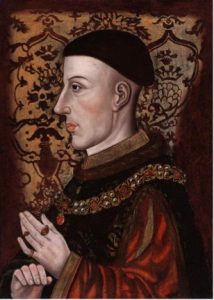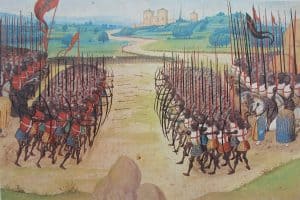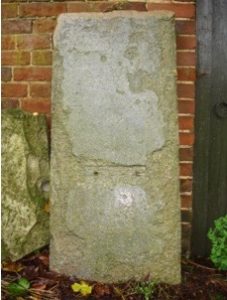
In 1415 Thomas Morsted of Betchworth was Henry V’s chief surgeon at the Battle of Agincourt.
The son of Thomas and Alianora Morsted, he had left the village to be apprenticed to a London surgeon. He became surgeon to the king in 1411. In 1412 Henry appointed him to the post of searcher of vessels in the port of London. (He would have paid agents from his fee to carry out the work.) Before leaving for war in France in 1415, he petitioned the king for money to buy and transport the surgical materials that the chief surgeon was required to provide. He and his team of junior surgeons served on campaign from July to November.
The invasion force sailed in August, landed at Harfleur and laid siege to the town. After the month-long siege Henry’s army was sick and depleted. Rather than march on Paris, Henry headed for the English port of Calais. The bedraggled English army was met by a vastly larger French army at the village of Azincourt on October 25th. Henry V’s unexpected victory was historic.

The Battle of Agincourt was fought outside the village of Azincourt between Normandy and Calais.
Thomas Morsted was paid 1s per day in France, and 40 marks for the year in Gascony (the same terms as the fighting men.) He had to provide and pay for three archers, three horses and twelve more surgeons. The assistant surgeons were paid 6d per day (the same as the archers).
The surgeons at Agincourt were kept busy with the English wounded. They were stationed on the higher ground, away from the arena of battle. They also had to prepare the bodies of men of high degree for the journey for burial in England. The surgeons boiled and de-fleshed the bodies of the Duke of York and the Earl of Suffolk the night after the battle. The rest of the bodies were burned.
Henry V of England claimed the throne of France through his ancestor Queen Isabella of France (wife of Edward II and mother of Edward III, whose victories at Crécy and Poitiers in the previous century had kept English kings’ hopes of the French throne alive.)
The victory at Agincourt lead to a treaty with the King of France, whereby Henry married the French princess, Katherine of Valois, and their children took precedence in the French succession over Katherine’s brother, the Dauphin. Henry and Katherine’s son, Henry VI was proclaimed King of England at the age of nine months on his father’s death, and King of France shortly afterwards. But he failed to hold on to his father’s gains in France.

After Henry’s death in 1422, Morsted became surgeon to the infant Henry VI. He was now a wealthy man: his second wife was an heiress and he owned a handsome London house which probably had a private chapel. He owned lands and annuities in Wotton in Surrey and in London, Essex, Middlesex, and Lincolnshire.
Morsted never forgot Betchworth. In his will he left funeral torches, a missal, chalice, silver platen and a pair of candelabra to Betchworth church. From his London rents he bequeathed money each Easter for the repair of the chapel ‘in whiche my fader and my moder ben buried.’
He also left 33 shillings for distribution amongst a hundred poor residents of Betchworth and Brockham (4 pennies to each).

Thomas and Alianora were the parents of Thomas Morsted, the surgeon. Made of Sussex marble (Winklestone) the slab was found during work carried out in the Lady Chapel for a new vestry. It was without its brass which is now mounted on the south wall of the new vestry. The brass had probably been parted from the slab during Victorian renovations of the church.

The inscription on the brass is in Latin. In translation it reads:
‘Here lie Thomas Morsted & Alianora his wife may their souls be brought near to God Amen’
The brass was probably commissioned by their son, the surgeon Thomas Morsted. Thomas and Alianora had other children, several girls and at least one boy. Their son John died in the service of the Duke of Clarence in 1421. In his will Thomas Morsted left money for prayers to be said for himself and his first wife Juliana, and for his parents and brothers and sisters, every year for 20 years after his death. He died in 1450.
Last : The Black Death
Next : The Battle of Agincourt

